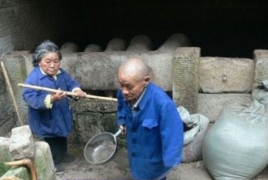 Mysterious village of dwarfsBlack turtle’s curse The remote Chinese village known as Yangsi that has baffling scientists for decades is located in the country’s southwest Sichuan Province. It’s a very unusual place, as around 40% of its population are dwarfs, who were all born and raised there. Because of the large number of height-challenged residents, Yangsi is known as the ‘Village of Dwarfs’. PanARMENIAN.Net - Village elders say that their peaceful, happy life was ruined on a summer night in 1951, when a strange disease struck the region. Several locals suffered from a mysterious condition that mainly affected young children between the ages of 5 and 7. These children just stopped growing, remaining at the same height for the rest of their lives. Apart from their inability to grow taller, some of the victims also suffered from various disabilities. A census was conducted in 1985, discovering about 119 such cases in the village. Apparently, the disease did not stop with the original victims; it was passed on to the next generation as well. As of 2014, 36 of the village’s 80 residents were dwarfs – the tallest one being about 117 cm tall and the shortest about 64cm. Dwarfism is short stature that results from a genetic or medical condition. Dwarfism is generally defined as an adult height of 147 centimeters or less. The average adult height among people with dwarfism is 122 cm. Many different medical conditions cause dwarfism. In general, the disorders are divided into two broad categories: -Disproportionate dwarfism. If body size is disproportionate, some parts of the body are small, and others are of average size or above-average size. Disorders causing disproportionate dwarfism inhibit the development of bones. -Proportionate dwarfism. A body is proportionately small if all parts of the body are small to the same degree and appear to be proportioned like a body of average stature. Medical conditions present at birth or appearing in early childhood limit overall growth and development. Scientists and experts visited Yangsi to study the water, soil and grain in the area. They also examined the affected individuals, hoping to find some clues. In 1997, a new theory suggested a high concentration of mercury in the soil, but it hasn’t been proven yet. However, experts were unable to determine the cause behind the condition and it remains as mysterious today, as it was some 60-odd years ago. Not denying the existence of the village, Chinese authorities, however, keep the place closed to foreigners. So, there are only a few photographs of the natives and some very bizarre rumors. Although the condition was officially recorded in 1951, reports of dwarf sightings date as far back as 1911. According to Oddity Central, English scientist Dr. Karyl Robin Evans claimed in 1947 to have seen a few hundred dwarfs living in a remote valley, in the area where Yangsi is located. Having no scientific explanation of the phenomenon, the villagers began to believe that evil forces were at work. Some blamed the bad feng shui (Chinese philosophical system of harmonizing everyone with the surrounding environment of the area), while others thought it was because their ancestors were not given a better burial. But the most bizarre theory so far states that a long time ago, a man named Wang spotted a black turtle with strange feet. Some of the villagers wanted to let it go, but they ended up roasting and eating it. When the disease struck, they started to believe that they might have been better off releasing the turtle. Some people blame toxic gases from when the Japanese invaded China many years ago. But the Japanese never reached the village of Yangsi, a fact that the villagers are not willing to accept. Throughout the years, several residents have left the region in fear of being affected by the strange condition, but things seem to be improving and, according to reports, the new generation seems to be unaffected by the weird dwarfism phenomenon. Lusine Mkrtumova / PanARMENIAN.Net How collection of horned creatures turned into museum New York’s first female crime boss World’s largest boneyard An Italian photojournalist’s journey through the pandemic Quarantine in metropoles Town without newborns and dead Nine months in the Pacific |